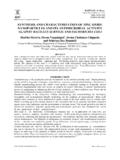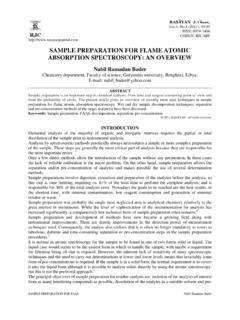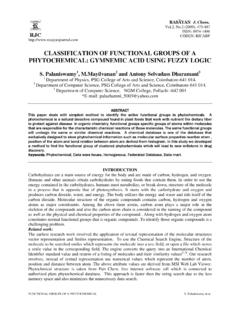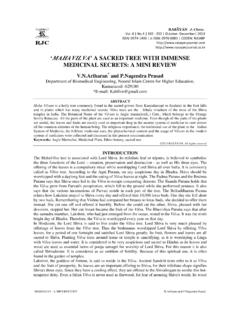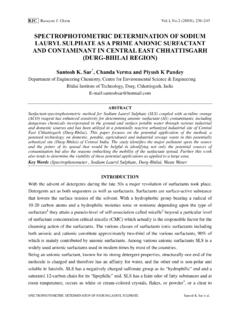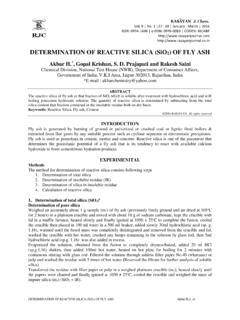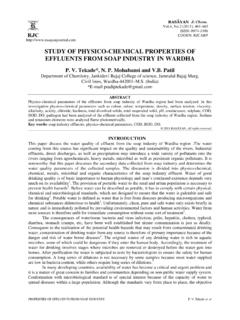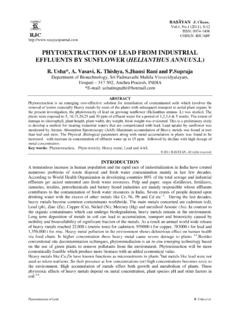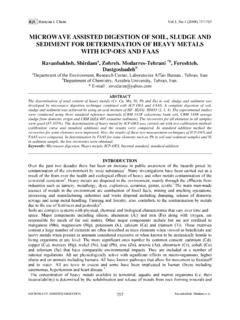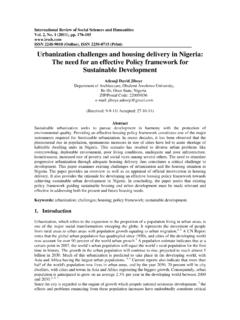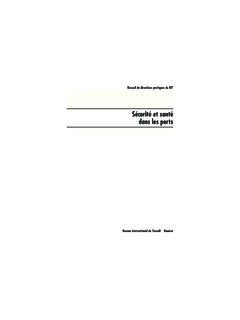Transcription of IMPACT OF PHARMACEUTICAL WASTES ON …
1 Vol. 8 | |67-70 | January - March | 2015. ISSN: 0974-1496 | e-ISSN: 0976-0083 | CODEN: RJCABP. Estd. 2008 IMPACT OF PHARMACEUTICAL WASTES ON HUMAN LIFE. AND ENVIRONMENT. Chanti Babu Patneedi* and K. Durga Prasadu Visakhapatnam, 530041. *E-mail: ABSTRACT. Now days, concerns about the occurrence and fate of active PHARMACEUTICAL ingredients, solvents, Intermediates and raw materials that could be present in water and wastewater including PHARMACEUTICAL industry waste water have gained increasing attention. Traditional wastewater treatment methods, such as activated sludge, are not sufficient for the complete removal of active PHARMACEUTICAL ingredients and other wastewater constituents from these waters. Environment and health are directly or indirectly affected by PHARMACEUTICAL effluents especially in the vicinity of pharma industrial zones. Though untreated or partially treated effluents released by pharma industries, drinking water sources are being polluted.
2 Different classes of PHARMACEUTICAL compounds like analgesic, antidepressant, antihypertensive, contraceptive, antibiotic, steroids and hormones etc. have been detected in water samples from mg/L to g/L range. Though the detected amounts are very minute but highly toxic for human, animal and aquatic lives. There is a need of regular monitoring of concentration of PHARMACEUTICAL compounds in PHARMACEUTICAL effluents entering into drinking water sources in order to save environment as well as living form of lives from health hazards. The present paper highlights such toxicity, health risk and assessment of environmental hazards due to PHARMACEUTICAL pollutants. Key words: PHARMACEUTICAL effluent, Industrial wastewater, Health Hazards. 2015 RAS YAN. All rights reserved INTRODUCTION. PHARMACEUTICAL compounds are being used for several beneficial purposes in modern society but simultaneously pharma industries are releasing very toxic contaminants in the environment directly or after chemical Moreover, PHARMACEUTICAL compounds may enter the environment by different routes such as discharge of treated wastewater, seepage from landfills sites, sewer lines, runoff from animal WASTES ,3 Even though various physical and biological processes occurring in aquatic ecosystem may cause reduction of many PHARMACEUTICAL compounds, trace concentrations of human and veterinary PHARMACEUTICAL compounds as well as their metabolites have been detected in different water bodies like surface water, groundwater and drinking water PHARMACEUTICAL industry in India is the world's third-largest in terms of volume and stands 14th rank in terms of value.
3 It is growing at about 8 to 9 percent annually and is estimated to be worth billion dollar. Different industries including pharmaceuticals, chemicals, paints etc. are speedily growing in India which disposes off their effluents into the streams either directly or after partial It has been found that the PHARMACEUTICAL compounds reach the environment and can be considered as environmental pollutants. Several PHARMACEUTICAL production facilities were found to be sources of much higher environmental concentrations than those caused by the applications of Generally, PHARMACEUTICAL industries generate a huge quantity of WASTES during manufacturing and maintenance operations. Pharmaceuticals have been detected in wastewater treatment plant effluents and drinking water sources. Trace amount of pharmaceuticals in drinking water for longer duration may cause considerable adverse effects to human health and aquatic life, though concentrations of pharmaceuticals detected in drinking water (in nano gram per liter range) are several orders of lower magnitude than the minimum therapeutic dose.
4 9 There is currently no Bureau of Indian Standards (BIS)/ regulations limiting the levels of pharmaceuticals in wastewater or drinking water. However, the United States Environmental Protection Agency10 has added four PHARMACEUTICAL compounds, which extensively used by human, to the most recent contaminant IMPACT OF PHARMACEUTICAL WASTES Chanti Babu Patneedi and K. Durga Prasadu Vol. 8 | |67-70 | January - March | 2015. candidate list (CCL 3) including three birth control substances and one antibiotic. The present paper highlights and reviews the IMPACT of PHARMACEUTICAL effluents on nearby drinking water sources. General Environmental Pollutants PHARMACEUTICAL Compounds PHARMACEUTICAL drugs being used for human as well as veterinary medicines are emerging as environmental pollutants. Different pharmaceuticals have been classified as Analgesics, Antibiotics, Antiepileptic, Antiseptics, Beta-blockers, Antihypertensive, Hormones, Contraceptives, Psychotherapeutics and Anti Pharmaceuticals in the Environment The environmental exposure routes of pharmaceuticals into the environment are manufacturing units and hospital effluents, land applications ( , bio solids and water reuse) etc.
5 12 However; sewage treatment services are not always successful in removing the active chemicals from waste -water. Consequently, pharmaceuticals find their way into the aquatic environment, where they directly affect aquatic organisms and can be incorporated into food chains. In a recent study, the extraordinarily high levels (mg/L) of several drugs were found in the effluents from local wastewater treatment plant near Visakhapatnam in India. Toxicity due to Some PHARMACEUTICAL Compounds Studies on antibiotics have shown that up to 95% of antibiotic compounds can be released unaltered into the sewage system. Moreover, higher concentrations of antibiotics can lead to change in microbial community structure and ultimately affect food chains. Non-steroidal anti-inflammatory drugs (NSAIDs), like ibuprofen, naproxen and diclofenac are widely being used and consequently are frequently detected in sewage, surface water and may be found in ground water system.
6 Ibuprofen, ketoprofen, naproxen, indomethacin, diclofenac, acetyl salicylic acid and phenazone have been found in surface water system. However, diclofenac, ibuprofen and propyphenazone are the most commonly found drugs in the water bodies after clofibric acid. Moreover, diclofenac has been proven to be highly toxic for vultures and cattle's. 13 NSAIDs like ibuprofen, naproxen and aspirin are the most commonly used drugs, which are usually found in effective quantities in municipal , 15. Properties of PHARMACEUTICAL Effluents Many PHARMACEUTICAL industries are responsible to generate toxic effluent as a consequence of their operation. The waste water generated from these industries possess solids, biodegradable and non degradable organic compounds etc. PHARMACEUTICAL effluents offer basic information about the reliability of the aquatic habitat in rivers and streams, into which they are discharged.
7 The physico-chemical analysis of the effluents should indicate that most of these industries obey the standard guidelines of Federal Environmental Protection Agency (FEPA).10 An important pollution index of industrial wastewaters is the oxygen content in chemical oxygen demand (COD) and biological oxygen demand (BOD), where the nutrients status are measured in terms of amount of nitrogen and phosphorus in waste water. Besides this, other significant water quality parameters include pH, temperature and total suspended solids (TSS).16 However; PHARMACEUTICAL effluents are also categorized by their unusual turbidity, conductivity, COD, TSS and total hardness. Pharmaceuticals Analysis in Drinking Water The mystery of PHARMACEUTICAL occurrence in drinking water has particularly concerned the public health. While unpleasant human health results from the existing levels of drugs and pharmaceuticals in drinking water are highly unlikely, the resulting impacts to aquatic ecosystems are more dangerous.
8 Moreover, pharmaceuticals have been detected in waters for more than four decades. In the past decade, the number of papers on the analysis of drugs or pharmaceuticals in drinking water sources has increased IMPACT OF PHARMACEUTICAL WASTES 68 Chanti Babu Patneedi and K. Durga Prasadu Vol. 8 | |67-70 | January - March | 2015. In a monitoring study, out of fourteen PHARMACEUTICAL drugs analyzed, some pharmaceuticals like acetaminophen (detection frequency ), codeine ( ), p-xanthine ( ), sulfamethoxazole ( ), caffeine ( ), carbamazepine ( ) and trimethoprim ( ) have been detected at concentrations more than or equal to detection limits of selected methods. Besides, detection frequencies of pesticides (33%) and trihalomethanes (28%) in the same sources were reported considerably higher 17. The pharmaceuticals have been identified in water cycle at trace levels by advanced analytical techniques and instrumentation.
9 Several reports have confirmed the presence of pharmaceuticals in effluents of pharma industries and in municipal wastewaters and these have been recognized as a major source of drugs and pharmaceuticals in drinking water. Most of the research work has been performed on the analysis and detection of PHARMACEUTICAL in drinking water samples in developed countries including USA, Japan, the Republic of Korea and some countries in Health Risk of PHARMACEUTICAL Effluents The long term exposure of lower concentration of complex PHARMACEUTICAL mixtures on stream biota may result in acute and chronic damages 18, 19, behavioral changes 20, 21, accumulation in tissues 22, reproductive damage 23 and inhibition of cell studies have demonstrated that fish exposed to wastewater effluents can exhibit reproductive abnormalities. Moreover, fish exposed to trace levels of birth control pharmaceuticals in the range of concentrations found in the environment show dramatic decreases in reproductive success, suggesting population level impacts are Assessment of Environmental Hazard Globally, the detection of waste pharmaceuticals in the environment creates the risks, which are associated with their introduction into human, aquatic life and wildlife and is becoming a serious problem equally for both regulators and the pharma industry.
10 Significant success on this issue is simply not achievable with the currently limited state of knowledge on environmental transport, fate, and effects of pharmaceuticals. There is need to take into consideration the possible growing effects of different drugs affecting the same receptors12, Risk assessment of the pharma chemicals involves the detection of the inherent hazards at each stage and an estimation of the risks due to these hazards. CONCLUSION. Currently, PHARMACEUTICAL compounds are being merged into the environment in extremely large quantities regularly and present system of regulations of their release is not able to control the untreated or partially treated pharma effluents. The impacts of drugs are entering into and occurring on ecosystems, biota and humans. The side effects on human, aquatic and animal health need to be investigated through thorough safety and toxicological studies.
